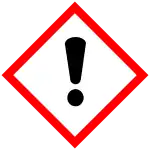Strontiumwolframat
Strontiumwolframat ist eine anorganische chemische Verbindung des Strontiums aus der Gruppe der Wolframate.
| Strukturformel | ||||||||||||||||
|---|---|---|---|---|---|---|---|---|---|---|---|---|---|---|---|---|
 | ||||||||||||||||
| Allgemeines | ||||||||||||||||
| Name | Strontiumwolframat | |||||||||||||||
| Andere Namen |
Strontiumwolframoxid | |||||||||||||||
| Summenformel | SrWO4 | |||||||||||||||
| Kurzbeschreibung |
weißer geruchloser Feststoff[1] | |||||||||||||||
| Externe Identifikatoren/Datenbanken | ||||||||||||||||
| ||||||||||||||||
| Eigenschaften | ||||||||||||||||
| Molare Masse | 335,46 g·mol−1 | |||||||||||||||
| Aggregatzustand |
fest[2] | |||||||||||||||
| Dichte |
6,439 g/cm3 (25 °C)[3] | |||||||||||||||
| Schmelzpunkt | ||||||||||||||||
| Sicherheitshinweise | ||||||||||||||||
| ||||||||||||||||
| Soweit möglich und gebräuchlich, werden SI-Einheiten verwendet. Wenn nicht anders vermerkt, gelten die angegebenen Daten bei Standardbedingungen. | ||||||||||||||||
Gewinnung und Darstellung
Strontiumwolframat kann durch Reaktion von Strontiumcarbonat mit Wolfram(VI)-oxid bei hohen Temperaturen gewonnen werden.[3]
Eigenschaften
Strontiumwolframat ist ein weißer geruchloser Feststoff.[2] Er besitzt eine tetragonale Kristallstruktur vom Scheelittyp mit der Raumgruppe I41/a (Raumgruppen-Nr. 88).[3][5] Bei einem Druck von 2,1 GPa wandelt sich diese in eine monokline Kristallstruktur vom Wolframittyp mit der Raumgruppe P2/n (Raumgruppen-Nr. 13, Stellung 2).[4] Bei einem Druck von etwa 10 GPa geht die Verbindung dann in eine Kristallstruktur vom Fergusonittyp über.[6]
Verwendung
Strontiumwolframat wird als elektrooptisches Material z. B. für Raman-Laser[7] und Leuchtdioden[8] verwendet.[9]
Einzelnachweise
- Datenblatt Strontiumwolframat bei AlfaAesar, abgerufen am 14. Juni 2016 (PDF) (JavaScript erforderlich).
- Datenblatt Strontium tungsten oxide, powder, −200 mesh, 99.9% trace metals basis bei Sigma-Aldrich, abgerufen am 14. Juni 2016 (PDF).
- Jiandong Fan, Huaijin Zhang, Zhengping Wang, Wenwei Ge, Jiyang Wang: Synthesis of polycrystalline materials of SrWO4 and growth of its single crystal. In: Frontiers of Chemistry in China. 1, 2006, S. 264, doi:10.1007/s11458-006-0023-z.
- E. Yu Tonkov: High Pressure Phase Transformations Handbook 1. CRC Press, 1992, ISBN 978-2-88124-758-3, S. 620 (eingeschränkte Vorschau in der Google-Buchsuche).
- M.A.M.A Maurera, A.G Souza, L.E.B Soledade, F.M Pontes, E. Longo, E.R Leite, J.A Varela: Microstructural and optical characterization of CaWO4 and SrWO4 thin films prepared by a chemical solution method. In: Materials Letters. 58, 2004, S. 727, doi:10.1016/j.matlet.2003.07.002.
- D. Errandonea, J. Pellicer-Porres, F. J. Manjón, A. Segura, Ch. Ferrer-Roca, R. S. Kumar, O. Tschauner, P. Rodríguez-Hernández, J. López-Solano, S. Radescu, A. Mujica, A. Muñoz, G. Aquilanti: High-pressure structural study of the scheelite tungstates CaWO4 and SrWO4. In: Physical Review B. 72, 2005, doi:10.1103/PhysRevB.72.174106.
- Xin-Tao Wu, Ling Chen: Structure-Property Relationships in Non-Linear Optical Crystals II The IR Region. Springer, 2012, ISBN 978-3-642-29621-5, S. 81 (eingeschränkte Vorschau in der Google-Buchsuche).
- Yandong Ren, Yonghao Liu, Rui Yang: A series of color tunable yellow–orange–red-emitting SrWO4:RE (Sm3+, Eu3+–Sm3+) phosphor for near ultraviolet and blue light-based warm white light emitting diodes. In: Superlattices and Microstructures. 91, 2016, S. 138, doi:10.1016/j.spmi.2015.12.026.
- Xiaohua J. Huang: Nanotechnology Research New Nanostructures, Nanotubes and Nanofibers. Nova Publishers, 2008, ISBN 978-1-60021-902-3, S. 75 (eingeschränkte Vorschau in der Google-Buchsuche).
